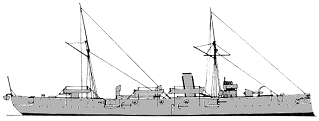
NAVYPEDIA
 Support the project with paypal
Support the project with paypal
Photo

Severn with funnel raised
Ships
| Name | No | Yard No | Builder | Laid down | Launched | Comp | Fate |
|---|---|---|---|---|---|---|---|
| Mersey | Chatham DYd | 9.7.1883 | 31.3.1885 | 6.1887 | sold 4.1905 | ||
| Severn | Chatham DYd | 1.1.1884 | 29.9.1885 | 2.1888 | sold 4.1905 | ||
| Thames | 209 | Pembroke DYd | 14.4.1884 | 3.12.1885 | 7.1888 | depot ship 1903 | |
| Forth | 211 | Pembroke DYd | 1.12.1884 | 23.10.1886 | 7.1889 | depot ship 1903 |
Technical data
| Displacement normal, t | 4050 |
|---|---|
| Displacement full, t |
|
| Length, m | 91.4 pp 96.0 oa |
| Breadth, m | 14.0 |
| Draught, m | 5.94 |
| No of shafts | 2 |
| Machinery | 2 2-cyl HC, direct action, 12 cylindrical boilers |
| Power, h. p. | natural draught: 4500 forced draught: 6000 |
| Max speed, kts | natural draught: 17 forced draught: 18 |
| Fuel, t | coal 900 |
| Endurance, nm(kts) | 8750(10) |
| Armour, mm | steel; deck: 76 - 51, gunshields: 51, CT: 229 |
| Armament | 2 x 1 - 203/30 BL Mk IV, 10 x 1 - 152/26 BL Mk IV/VI, 3 x 1 - 57/40 6pdr Hotchkiss Mk I, 3 x 1 - 47/40 3pdr Hotchkiss Mk I, 9 x 1 - 11.4/87, 2 - 356 TT (1 bow, 1 aft, sub), 2 - 356 TC |
| Complement | 325 |
Standard scale images

Mersey 1887
Graphics
Project history
These ships completed the stabilisation of the designs begun with the Iris and Mercury and established the pattern for future British second class cruisers. They followed closely the design of the Leander class but incorporated, for the first time, a full length protective deck. They were also the first vessels of the type to abandon any form of sailing rig and to be fitted with an armoured conning tower, which was positioned on the forecastle just forward of the mainmast. The 152mm guns were arranged as in Leander, except that all were mounted in sponsons on central pivot mountings in the Thames and Forth, while the two 203mm were mounted on the centreline on the forecastle and poop. They had much higher bulwarks than the Leanders and carried a spar deck amidships on which were mounted some of their MGs. The remaining internal arrangements were similar to those of the earlier types but they were the only major British cruisers of the late Victorian period with single funnels.
On trials both Thames and Severn exceeded 18kts, but Forth ran her trials in bad weather and only made 17.3kts while Mersey, which developed the highest, power at 6628ihp, did not have her speed recorded. They were handy ships, steady gun platforms and good sea bouts.
Ship protection
The armoured deck was 51mm on the flat and 76mm on the slope and at the forward end curved down to provide support behind the ram bow.
Modernizations
1893-1896, all: funnels were raised to improve the draught to the boilers
Naval service
Thames and Forth were converted to depot ships in 1903. Thames was sold in 1920 and became the TS General Botha Botha based at the Cape; in 1942 she reverted to her old name and was employed as an accommodation ship until 1945.
Many thanks to Wolfgang Stöhr for additional information on this page.
with funnel raised
 HOME
HOME FIGHTING SHIPS OF THE WORLD
FIGHTING SHIPS OF THE WORLD UNITED KINGDOM
UNITED KINGDOM CRUISERS
CRUISERS MERSEY 2 class cruisers (4, 1887 - 1889)
MERSEY 2 class cruisers (4, 1887 - 1889)
